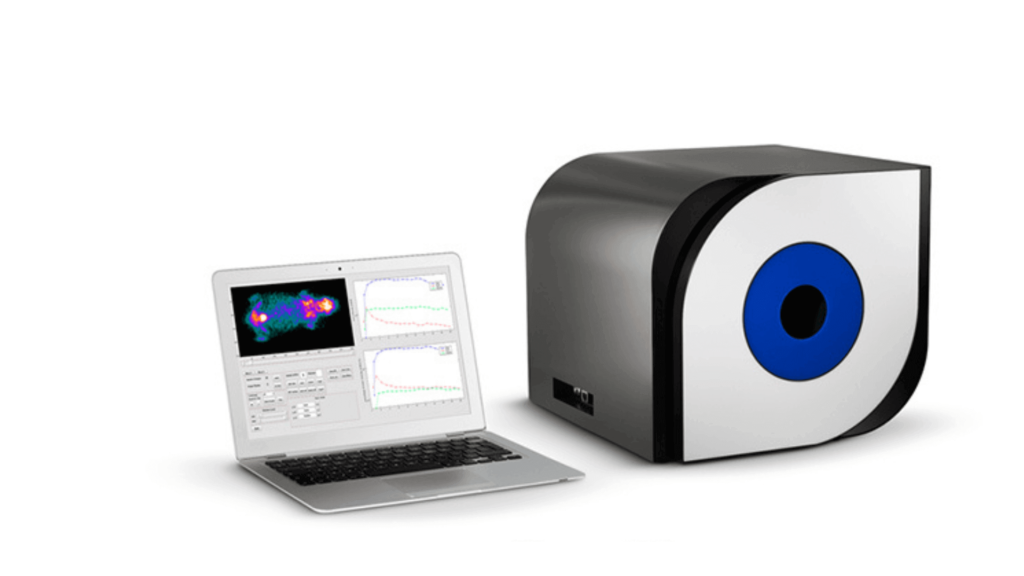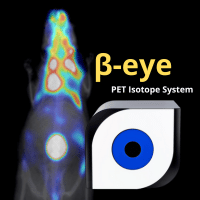System Used:
β-eye

Bioemtech’s β-eye is a 2D PET systems have emerged as a viable alternative to conventional 3D PET systems in preclinical research settings. While 3D PET systems have been the gold standard for high-resolution molecular imaging, Bioemtech’s 2D PET systems offer unique advantages and capabilities that make them appealing for specific applications. This article explores the features, imaging capabilities, applications, and potential impact on advancing scientific understanding.
If we take a step back and look at 2D vs 3D imaging from the perspective of optical imaging – either bioluminescence or fluorescence, then this comparison becomes a bit more familiar to the imaging world. With bioluminescence, for example, both 2D and 3D imaging is possible – often even within the same system. However, the majority of times, scientists will opt for higher throughput 2D imaging. It takes less time and provides sufficient data to answer the biological questions being asked. Now imagine, if that data became even more quantifiable, and any issues of depth of penetration were removed – how? by using a radioisotope rather than an optical tracer – by using PET imaging.
Preclinical PET imaging plays a crucial role in understanding disease mechanisms, evaluating therapeutic interventions, and assessing novel radiotracers in small animal models. Traditionally, 3D PET systems have dominated preclinical imaging due to their superior spatial resolution and sensitivity. However, Bioemtech’s 2D PET systems have gained attention as a promising alternative, offering distinct advantages for specific preclinical research applications.
The β-eye from Bioemtech, although using a different acquisition geometry, offers competitive imaging capabilities compared to conventional 3D PET systems. While 3D systems provide higher spatial resolution, 2D systems compensate with enhanced sensitivity and temporal resolution. These attributes make 2D systems well-suited for dynamic imaging studies, where the assessment of rapid physiological processes and radiotracer kinetics is crucial. Additionally, the higher sensitivity of 2D systems enables the detection of lower radiotracer concentrations, facilitating studies involving low-dose tracers, novel radiotracers, or short-lived isotopes.
In addition to the increased sensitivity, the β-eye systems are also more cost-effective than conventional PET systems, making them accessible to a broader range of research institutions and regions of the world with limited budgets. The simplified design and operation of 2D systems also allow for ease of use, faster installation, and reduced training requirements. Moreover, the systems’ higher sensitivity and temporal resolution enable real-time imaging and more precise quantification of dynamic processes, such as receptor binding, blood flow, and metabolic kinetics. These advantages position β-eyes as a valuable tool for preclinical studies involving dynamic imaging and novel radiotracer development.




Finally, the β-eye PET systems are so compact and simple to use, that they can turn any licenced space into an advanced imaging lab. They can easily be placed within an animal facility, as they fit easily on any available bench space, with no additional infrastructure requirements.
So even if an institution or lab has a conventional 3D PET system, there is still a place for, and often a need for an easier to use, and access, β-eye system – and several world-class institutions have done just that. Many have seen the value in having a β-eye system near the radiochemistry lab, and/or cyclotron to test compounds in development, prior to moving on to imaging in the 3D scanner. At times, the 3D scanner can be harder to access, and is often quite busy, making it challenging to use for rapid screening of developed target compounds.
Bioemtech’s 2D PET systems offer a promising alternative to conventional 3D PET systems in preclinical research. While 3D systems excel in spatial resolution, 2D systems compensate with higher sensitivity and temporal resolution, making them ideal for dynamic imaging studies and applications that prioritize real-time quantification. The cost-effectiveness, ease of use, and enhanced imaging capabilities of 2D systems position them as valuable tools in preclinical research, particularly for studies involving fast physiological processes, low-dose tracers, and novel radiotracer development. Researchers should carefully evaluate their specific imaging requirements to determine the most suitable system for their preclinical imaging needs, considering the trade-offs between spatial resolution and temporal sensitivity offered by Bioemtech’s β-eye system.
